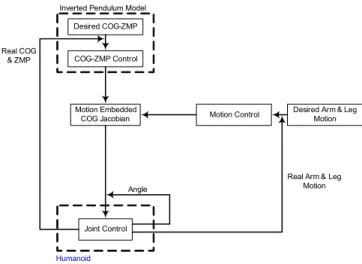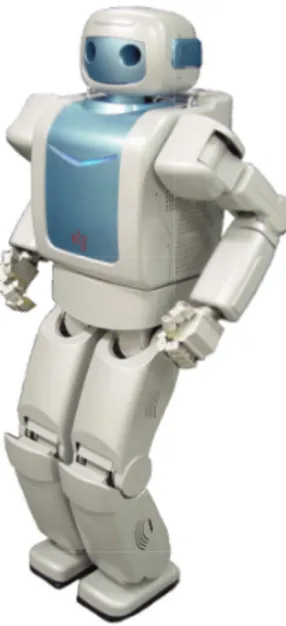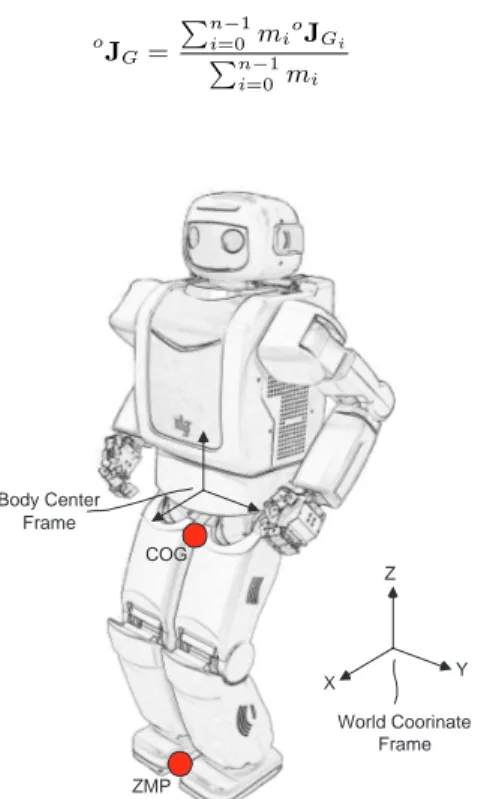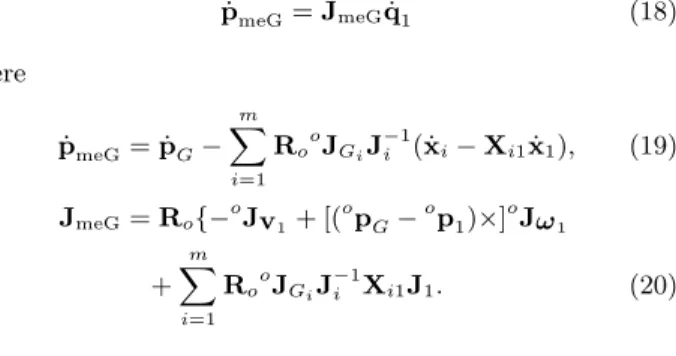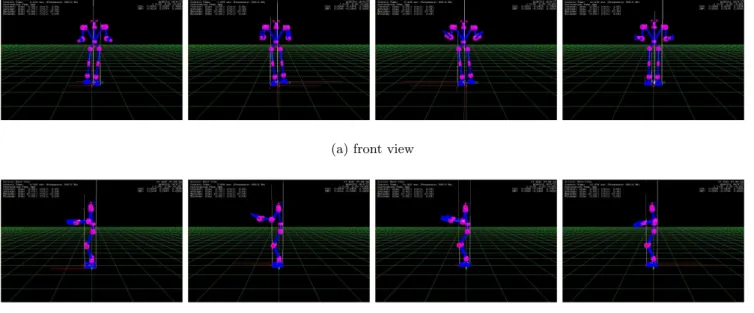ICCAS2005 June 2-5, KINTEX, Gyeonggi-Do, Korea
Real-Time Generation of Humanoid Motion with the Motion-Embedded COG
Jacobian
Doik Kim∗, Youngjin Choi∗, Yonghwan Oh∗, and Bum-Jae You∗
∗Intelligent Robotics Research Center, Korea Institute of Science and Technology(KIST), Seoul 136-791, Korea
(Tel: +82-2-958-5750; Fax: +82-2-958-5749; Email:{doikkim,cyj,oyh,ybj}@kist.re.kr)
Abstract: For a legged robot such as a humanoid, balancing its body during a given motion is natural but the most important problem. Recently, a motion given to a humanoid is more and more complicated, and thus the balancing problem becomes much more critical. This paper suggests a real-time motion generation algorithm that guarantees a humanoid to be balanced during the motion. A desired motion of each arm and/or leg is planned by the conventional motion planning method without considering the balancing problem. In order to balance a humanoid, all the given motions are embedded into the COG Jacobian. The COG Jacobian is modified to include the desired motions and, in consequence, dimension of the COG Jacobian is drastically reduced. With the motion-embedded COG Jacobian, balancing and performing a task is completed simultaneously, without changing any other parameters related to the control or planning. Validity and efficiency of the proposed motion-embedded COG Jacobian is simulated in the paper.
Keywords: Humanoid, COG, COG Jacobian, Balancing, Motion Generation
1. Introduction
A high mobility of a humanoid makes it difficult to gener-ate a motion and to interact with environment in real time. Many previous works in motion generation of a humanoid is to replay a pre-defined joint motion and modify it little by a certain control method in real situation. For a complicated, smooth and agile motion, it is necessary to develop a real time motion generating method. In addition, it is desired to include dynamics to improve the stability of a humanoid. Dynamics, however, requires a large amount of computation. The center of gravity(COG) can be a simple alternative of full dynamics, since it can be treated as a usual kinemat-ics which needs less computation tan that of dynamkinemat-ics, and ,furthermore, it reflects dynamic properties such as the mass and the mass center of each link. Thus, the COG is the important property which relates to the stability, humanoid motion, and dynamics.
In order to use the COG relation in motion generation, the COG Jacobian is needed. The COG Jacobian is firstly pro-posed by Kagami, et al, in 2000, but they developed a nu-merical method[1]. An analytic formulation of the COG Ja-cobian is proposed by Sugihara, et al, in 2002[2], [3]. They used the COG Jacobian as follows: At first, the ZMP tra-jectory is predefined and it is used as a desired motion of the COG Jacobian. Motions of some limbs are used as con-straints. An optimization problem that satisfies the COG Jacobian and given constraints simultaneously, are solved to generate joint motion.
As an application, Sugihara, et al, used the COG Jacobian for whole body cooperative balancing, but the method needs large computation in optimization. The method proposed in this paper is that a given motion is embedded in the COG Jacobian and thus the dimension of the modified COG Ja-cobian is reduced and the number of constraints are also reduced since motions are embedded. In addition, the mod-ified COG Jacobian guarantees the balancing a humanoid and performing a task.
This paper is organized as follows: Section 2.describes the overall system. Section 3. introduces the COG Jacobian suggested by Sugihara, et al, in 2002[2], [3]. Section 4.derives the motion-embedded COG Jacobian. Section 5. simulates the suggested algorithm, and section 6. concludes the paper.
2. Overall System
For a human, if arms do a certain task, they focus on the task not on the balancing. The remaining parts of the human balance its body to do the task. The proposed method, i.e., the motion-embedded COG Jacobian, implements it. Con-sequently, when we plan a motion, balancing problem needs not to be considered, and furthermore, a conventional motion planning method can be applied without any modification.
Desired COG-ZMP
Desired Arm & Leg Motion COG-ZMP Control
Motion Control Inverted Pendulum Model
Motion Embedded COG Jacobian Joint Control Humanoid Angle Real COG & ZMP
Real Arm & Leg Motion
Fig. 1. Humanoid Control Flow
The overall control scheme can be divided into two major categories: 1) COG and ZMP related algorithms and 2) mo-tion related algorithms. The COG-ZMP related algorithms
are based on the inverted pendulum model1and the motion related algorithms focus on how to distribute the COG-ZMP profile and given task motion to each joint with guaranteing balance and performing a given task motion. Fig. 1 shows the overall control flow.
For the stability of a humanoid, the COG-ZMP profile is predefined for several basic motion, for example, for-ward/backward movement, side movement and turning. The COG-ZMP profile is derived from the inverted pendulum model, which gives relatively simple relation. COG is calcu-lated from the internal joint information, thus it represents the pose of a humanoid. ZMP is an dynamic property that represents the stability whether a humanoid is to be rollover or not. Two properties are tightly related, and therefore, the predefined COG-ZMP are controlled simultaneously with real COG and ZMP, in order to guarantee the pose and the stability.
Fig. 2. Mahru
Basically, a humanoid has four limbs attached at the main body. Hereafter, each limb and the main body will be called a section, and will be considered equally. For a human, a task is done with some sections, usually two arms, and balance the body with other sections, usually two legs. It means that not all sections are dedicated into one task, but they do their own tasks, for example, balancing or an inten-tional task. Thus the motion of each section can be given independently. The section is classified into an idle section and a busy section: the idle section has no given motion and the busy section has an intentional motion. If a section has zero motion, i.e., it is fixed at current position, it can be considered as an idle section or a busy section. In most case, a supporting section which is attached on the ground are considered as a busy section, since they have a role of
1In this paper, we don’t include the planning of COG and/or ZMP. You can
find this subject in reference[4], or other references.
balancing the body. An intentional motion of each limb or a main body can be given as a joint motion and/or a Carte-sian motion. If a busy section has an intentional motion in the Cartesian space, it will be called C-busy section and a section with an intentional motion in the joint space is J-busy section. Motion control step in Fig. 1 is done for a C-busy section. A J-busy section will be controlled at the joint control step.
The given intentional motion and corresponding COG-ZMP profile are distributed to joints of a humanoid, i.e., the mo-tion of the inverted pendulum model is transformed into the motion of a complicated multi-body model. By using the motion-embedded COG Jacobian, the stability and an in-tentional motion are guaranteed simultaneously.
The algorithm suggested in this paper is applied to the hu-manoid, Mahru, developed at KIST in 2004 shown in Fig. 2. Mahru has the height of about 150cm, and the weight is about 67kg. It has 6-dof for each legs and arms, 1-dof for the waist, 2-dof for the neck, and each hand has 4-dof. In total, it has 35-dof. A stereo camera is equipped.
3. COG Jacobian
Let us consider a n-DOF humanoid. There are two referen-tial frames to describe a humanoid as shown in Fig. 3. The world coordinate frame is fixed on somewhere in the world and represents the global motion of a humanoid. The body center frame is fixed on a humanoid to describe local motion. Almost all the properties of a humanoid is described in the
body center frame. The leading superscripto(·) implies that
the elements are represented in the body center frame.
The COG, pG, of a humanoid is a function of joint angle
vector, q, i.e., pG= f (q). Thus, there exists a Jacobian JG
which can relate ˙q to ˙pGas:
˙pG= JG˙q (1)
where the (3 × n) matrix JGis defined by
JG≡∂pG
∂q (2)
We call JGthe COG Jacobian hereafter. pGis a quite
com-plex function with multiple arguments. Kagami, et al, pro-posed the numerical method to calculate it[1], which unfor-tunately needs a large amount of computation. Sugihara, et al, developed a fast and accurate calculation method of JG
with the following approach[2].
Firstly, the relative COG velocity with respect to the body center frame,o˙p
G, can be expressed as:
o ˙pG= Pn−1 i=0 mi o˙r Gi Pn−1 i=0 mi = Pn−1 i=0 mi oJ Gi˙q Pn−1 i=0 mi (3) where mi is the mass of link i, orGi is the position of the
center of mass of link i with respect to the body center frame,
andoJ Gi (3 × n) is defined by o JGi ≡ ∂or Gi ∂q (4)
Therefore, JacobianoJ Gwhich relates ˙q too˙pGis oJ G= Pn−1 i=0 mi oJ Gi Pn−1 i=0 mi (5) Body Center Frame COG X Y Z World Coorinate Frame ZMP
Fig. 3. Coordinate System of Mahru
Secondly, suppose link 1 is the base section, which is fixed in the world frame (for example, when the right leg is the supporting leg, the right leg is fixed on the ground and be-comes the base section), the COG velocity with respect to
the world coordinates frame, ˙pGis
˙pG= ˙po+ ωo× RoopG+ Roo˙pG =Ro{o˙pG− o ˙p1+ ( o pG− o p1) × o ω1} =RooJG˙q + Ro{−oJv1+ [( o pG− o p1)×] o Jω1} ˙q1 (6)
where po is the position of the body center in the world
frame, ωo is the angular velocity of the body center with
respect to the world frame, Ro is the attitude matrix of
the body center with respect to the world frame,op
1 is the
position of the base section in the body center frame, oω
1 is the angular velocity of the base section with respect to
the body center frame, o
Jv1 is the Jacobian about linear
velocity of the base section with respect to the body center
frame, o
Jω1 is the Jacobian about angular velocity of the
base section with respect to the body center frame, and [v×]
means outer-product matrix of a vector v (3 × 1). ˙qi is the
joint velocity of section i. Note that the base section can be any section that is fixed on the ground, but here, we assigned the base section with the number 1 without loss of generality. In order to use Eq. (6) in the following section, it is rewritten here as: ˙pG= m X i=1 RooJGi˙qi + Ro{−oJv1+ [( o pG− o p1)×] o Jω1} ˙q1 (7)
where m is the number of sections.
Now, let us derive the motion-embedded COG Jacobian from Eq. (7).
4. Motion-Embedded COG Jacobian
4.1. Embedment of J-Busy Section
It is easy to embed a joint motion into the COG Jacobian, since the joint motion can be directly replaced ˙qiin Eq. (7).
If section j is a J-busy section, Eq. (7) becomes ˙pG− RooJGj˙qj = m X i=1,i6=j RooJGi˙qi + Ro{−oJv1+ [( o pG− o p1)×] o Jω1} ˙q1 (8)
The second term of the left hand side compensates the mo-tion of the jth secmo-tion. Therefore, the other secmo-tions shown in the right hand side can generate a joint motion with the compensated COG motion.
If at least one section, i.e., the base section, is an idle section, then Eq. (8) can compensate motion of the other sections. If all sections are the J-busy section, there is no section to compensate given motions. In this case, an optimization method needs to be applied.
4.2. Embedment of C-Busy Section
Let us derive the motion-embedded COG Jacobian for the C-busy section. Each section of a humanoid is considered as an independent section, i.e., any section can have its own motion independently without considering other sections. In general, the i-th section has the following relation:
o˙x
i=oJi˙qi (9)
where o˙x
i = [o˙pTi;oωTi]T is the end point velocity of the
section,o˙p
i andoωiare the linear and the angular velocity,
respectively. ˙qi is the joint velocity, and oJi is the usual
Jacobian matrix.
In our case, the body center is floating, and thus the end point motion about the world coordinate frame is written as follows:
˙xi= X−1i ˙xo+ Xoo˙xi (10)
where ˙xo = [ ˙poT; ωoT]T is the velocity of the body center
represented in the world coordinate system, and
Xi= " I3 [Roori×] 03 I3 # (11) is a (6 × 6) matrix which relates the body center velocity
and the end point velocity of the i-th section. I3 and 03are
an (3 × 3) identity and zero matrix, respectively. Ro is the
orientation of the body center based on the world coordinate
system. or
i is the position vector from the body center to
the end of the i-th section based on the body center frame.
The transformation matrix Xo is
Xo= " Ro 03 03 Ro # . (12)
By combining Eq. (9) and Eq. (10), the end point velocity based on the world coordinate system is
˙xi= X−1i ˙xo+ XooJi˙qi (13)
For simplicity, we will use the relation Ji= XooJi, hereafter.
From Eq. (13), we can see that all sections should satisfy the compatibility condition, i.e., the body center velocity derived from each section is the same to be connected without being broken., and thus the i-th section and the j-th section should satisfy the following relation:
Xi( ˙xi− Ji˙qi) = Xj( ˙xj− Jj˙qj). (14)
From Eq. (14), the joint velocity of any section can be repre-sented by the joint velocity of the base section. For example, the base section should be chosen to be the supporting leg in the single supporting phase or one of both legs in the double supporting phase if a humanoid is in walking. Let us express the base section with the subscript 1, then the joint velocity of any section is expressed as:
˙qi= J −1
i ˙xi− J−1i Xi1( ˙x1− J1˙q1), (15) for i = 2, · · · , m, where m is the number of sections. Here,
Xi1 = " I3 [Ro(ori−or1)×] 03 I3 # . (16)
Note that if a section is a redundant system, any null space
optimization scheme can be added in Eq. (15), and J−1
i
be-comes a generalized inverse.
By substituting Eq. (15) into Eq. (7), the motion-embedded COG Jacobian relation becomes
˙pG= Ro{−oJv1+ [( op G−op1)×]oJω1˙q1 + m X i=1 RooJGiJ −1 i ( ˙xi− Xi1˙x1) + m X i=1 RooJGiJ−1i Xi1J1˙q1 (17) where Jv1 = Ro o Jv1 and Jω1 = Ro o
Jω1 are the linear
and angular velocity part of the base section Jacobian. Note that if i = 1, ˙xi− Xi1˙x1 = 0 and RooJGiJ
−1
i Xi1J1˙q1 = RooJGi˙q1.
Finally, all desired motions, ˙xi, are embedded in the
modi-fied COG Jacobian. Thus the effect of the COG movement generated by the desired motion is compensated by the base section. Eq. (17) can be rewritten like the usual kinematic Jacobian of the base section:
˙pmeG= JmeG˙q1 (18) where ˙pmeG= ˙pG− m X i=1 RooJGiJ −1 i ( ˙xi− Xi1˙x1), (19) JmeG= Ro{−oJv1+ [( o pG− o p1)×] o Jω1 + m X i=1 RooJGiJ −1 i Xi1J1. (20)
The modified COG motion, ˙pmeG, consists of two relations:
a desired COG motion(the first term) and the relative effect of motion of sections(the second term). The modified COG
Jacobian, JmeG also consists of two relations: the effect of
the body center(the first term) and the effect of motion of sections(the second term).
The modified COG Jacobian JmeGis a (3×n1) matrix where
n1is the dimension of the base section, which is smaller than that of the original COG Jacobian. For example, Mahru in
Fig. 2 has a 6-dof leg, and thus n1= 6 if the leg is the base
section. After solving Eq. (18), the joint motion of the base section is obtained. The resulting base section motion bal-ances a humanoid robot automatically during the movement of all other sections. With the joint motion of the base sec-tion, the joint motion of all other sections are obtained by Eq. (15) to satisfy the desired motion. The resulting mo-tion follows the desired momo-tion, regardless of the balancing motion of the base section.
5. Simulation
In order to show the validity of the suggested algorithm, a dynamic simulator developed in KIST is used. The simulator can simulate a humanoid Mahru shown in Fig. 2.
To show the effect of the J-busy and C-busy section, simul-taneously, two arms are J-busy and two legs are C-busy. For simplicity, the humanoid walks at the spot as a desired leg motion. one of the left and right foot is moved up and down with a sinusoidal function in turn. Two motions for arms are given: 1) both arms are stretched forward as shown in Fig. 4 and 2) the right arm is raised and waves it shown in Fig. 5. The desired arm motions are obtained by the motion captured data[5]. In order to move the COG on the center of the supporting foot, a predefined COG-ZMP trajectory is applied.
The first motion, stretching two arms forward, can make the humanoid fall down since the mass is moved to the front of the humanoid. By using the motion-embedded COG Jaco-bian, the desired motion of arms are compensated by the supporting leg, and thus the leg moves the humanoid body back automatically as shown in Fig. 4 (b), the side view. The second motion, rasing and waving right hand, makes an large disturbance to the humanoid since the fast waving motion changes the mass center quickly to the left and right. Thus if the right hand goes to the right when the right foot is off the ground, it is difficult to move the COG and ZMP to the stable region, i.e., the left foot. However, the left leg compensates the motions of arms an the right leg by the motion-embedded COG Jacobian, and consequently, the COG and ZMP are still in the stable region as shown in Fig. 5.
The overall motions are complicated and it is easy to make
the humanoid unstable. However, by using the
motion-embedded COG Jacobian, any parameters such as control gain, COG/ZMP trajectory, and etc, need not to be changed to stabilize or balance the humanoid.
(a) front view
(b) side view
Fig. 4. example 1: both arms move forward
(a) front view
(b) side view
Fig. 5. example 2: right arm is raised and waves
6. Concluding Remark
In this paper, a real-time motion generation method for a humanoid is suggested. A desired motion of each section is obtained by the conventional motion planning method with-out considering the balancing problem.
The method can balance a humanoid by using the motion-embedded COG Jacobian. The suggested motion-motion-embedded COG Jacobian reduces the computation time to generate a motion and guarantee the given motion and the balance, simultaneously.
In the paper, we assume that all the sections have their own
tasks. If a section does not have a desired motion, i.e., an idle section, there are two possible cases:
1. the idle section is considered as a busy section with a zero motion, i.e., it is fixed at the current position. In this case, the section can be considered as a C-busy section, and the method suggested in this paper can be applied.
2. with some optimization scheme, the idle section can be used actively to balance the humanoid. Since the idle section has no desired motion, by changing its position actively, the humanoid can balance the body more easily and naturally. The optimization of the idle section is still under develop-ment.
exam-ined by the simulation. Two motions are applied to the hu-manoid, and without changing any parameters on the control or COG/ZMP motion, the humanoid performed the given motions and it also balanced its body.
References
[1] S. Kagami, F. Kanehiro, Y. Tamiya, M. Inaba, and H. In-oue, “Autobalancer: An online dynamic balance compen-sation scheme for humanoid robots,” in The 4th Interna-tional Workshop on Algorithmic Foundation on Robotics (WAFR’00), 2000, no Paper.
[2] T. Sugihara, Y. Nakamura, and H. Inoue, “Realtime hu-manoid motion generation through ZMP manipulation based on inverted pendulum control,” in IEEE Interna-tional Conference on Robotics and Automation, Wash-ington, DC, may 2002, pp. 1404–1409.
[3] T. Sugihara and Y. Nakamura, “Whole-body cooperative balancing of humanoid robot using COG jacobian,” in International Conference on Intelligent Robots and Sys-tems, EPFL, Lausanne, Swizerland, oct 2002, pp. 2575– 2580.
[4] Y. Choi, B.-J. You, and S.-R. Oh, “On the stability of in-direct ZMP controller for biped robot systems,” in Inter-national Conference on Intelligent Robots and Systems, sep 2004, pp. 1966–1971.
[5] C. Kim and D. Kim, “Adaptation of motion capture data of human arms to a humanoid robot using optimization,” in ICCAS2005, jun 2005. (accepted).
